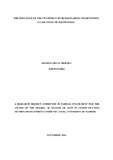The Influence of the Cnn Effect on Humanitarian Intervention: a Case Study of South Sudan
| dc.contributor.author | Meroka, George O | |
| dc.date.accessioned | 2017-01-06T07:49:10Z | |
| dc.date.available | 2017-01-06T07:49:10Z | |
| dc.date.issued | 2016 | |
| dc.identifier.uri | http://hdl.handle.net/11295/99486 | |
| dc.description.abstract | This study sought to establish the extent of influence of the CNN effect in South Sudan‟s humanitarian crisis as its main objective. The study sought to fill a gap in the CNN effect research of how global media through the CNN effect influenced intervention in South Sudan‟s humanitarian crisis by American policy makers. Previous studies had looked at how the CNN effect phenomenon in the post-Cold War world had influenced intervention in diverse conflicts and crises in Somalia, Bosnia and Kosovo. This further strengthened the need to fill a gap in our understanding of how changed circumstances since those interventions may or may not have caused intervention through the CNN effect. To fill in the gap the following main research question was raised: How has the CNN effect along with the framing of South Sudan‟s crisis influenced intervention by policy makers in the evolving humanitarian crisis or lack of it? Specific questions raised by the study were: How did the news media frame the South Sudan humanitarian crisis? Did non-media factors play a role in the intervention or non-intervention of South Sudan‟s humanitarian crisis? A mixed method methodology involving the use of content analysis and textual analysis of 17 articles in the Washington Post and 24 articles from the New York Times along with 25 press statements from the U.S. State Department and 9 from the White House was employed. The study used Piers Robinson‟s Policy-Media interaction model as it theoretical basis. The study finds that distance frame key words were used more times compared to empathy frame key words; the study also reveals that moral responsibility framing was used in both Washington Post and the New York Times to influence U.S. Policy makers to intervene in South Sudan‟s humanitarian crisis. It also finds that U.S Policy makers are increasingly pushing intervention in conflicts and crisis towards regional states and regional organizations including the United Nations (U.N) to take the lead in coming up with interventions to crisis as the case with South Sudan as revealed in the study. The study concludes that CNN effect of the postCold War era is no longer effective in explaining media influence in today‟s conflicts and crises such as South Sudan as it does not capture the dynamics of the changed geostrategic and international relations landscape. The study recommends that policy makers and media practitioners‟ develop an integrated media-policy framework that brings together the divergent issues that have caused discord between media practitioners‟ and policy makers which will guide and strengthen humanitarian crisis intervention reporting and intervention response. | en_US |
| dc.language.iso | en | en_US |
| dc.publisher | University of Nairobi | en_US |
| dc.rights | Attribution-NonCommercial-NoDerivs 3.0 United States | * |
| dc.rights.uri | http://creativecommons.org/licenses/by-nc-nd/3.0/us/ | * |
| dc.title | The Influence of the Cnn Effect on Humanitarian Intervention: a Case Study of South Sudan | en_US |
| dc.type | Thesis | en_US |



